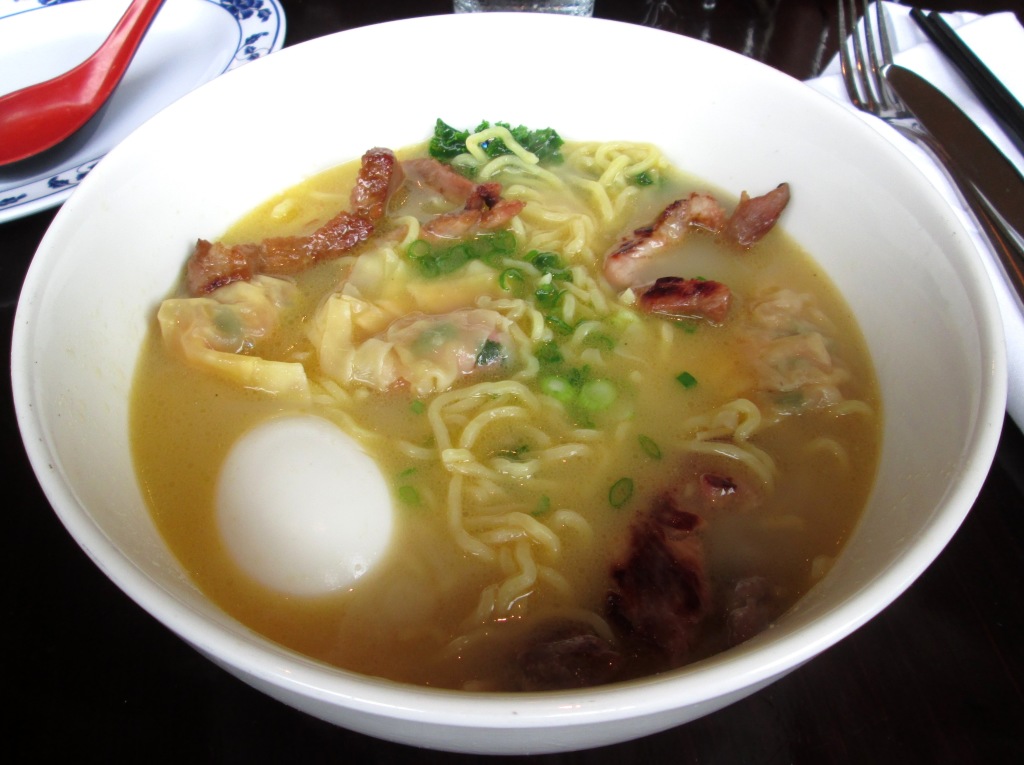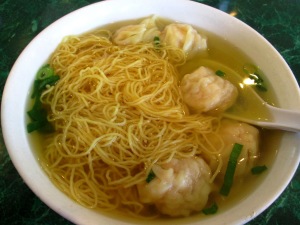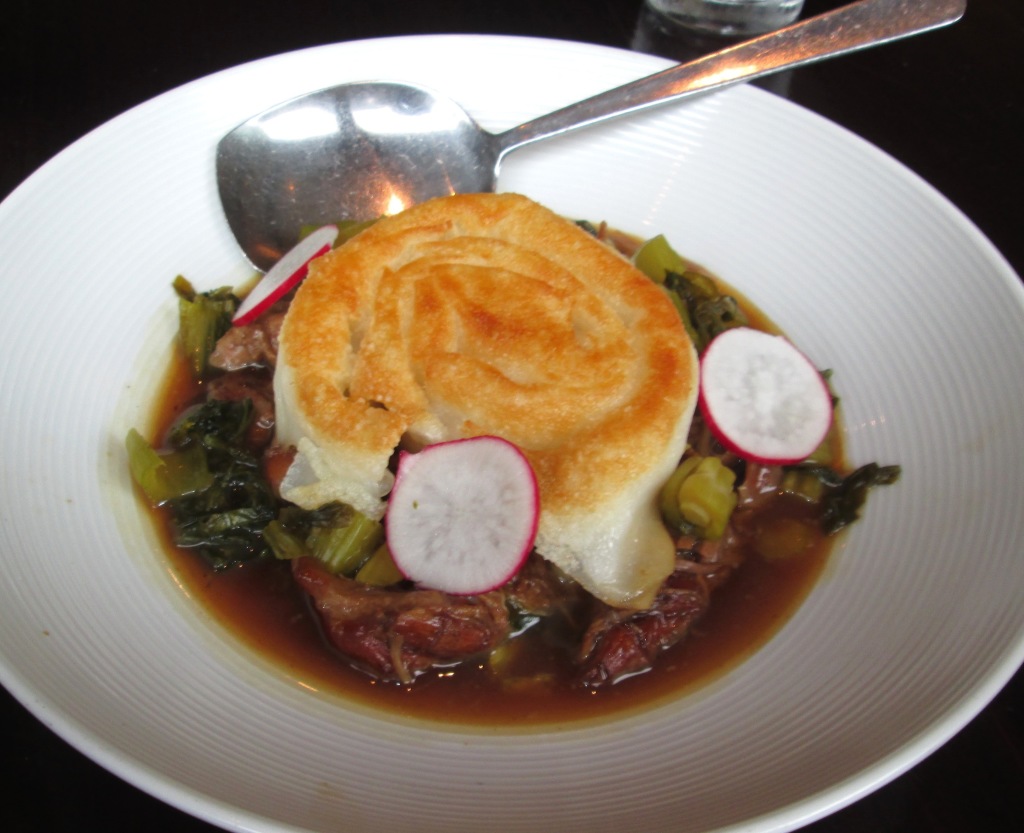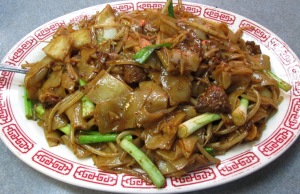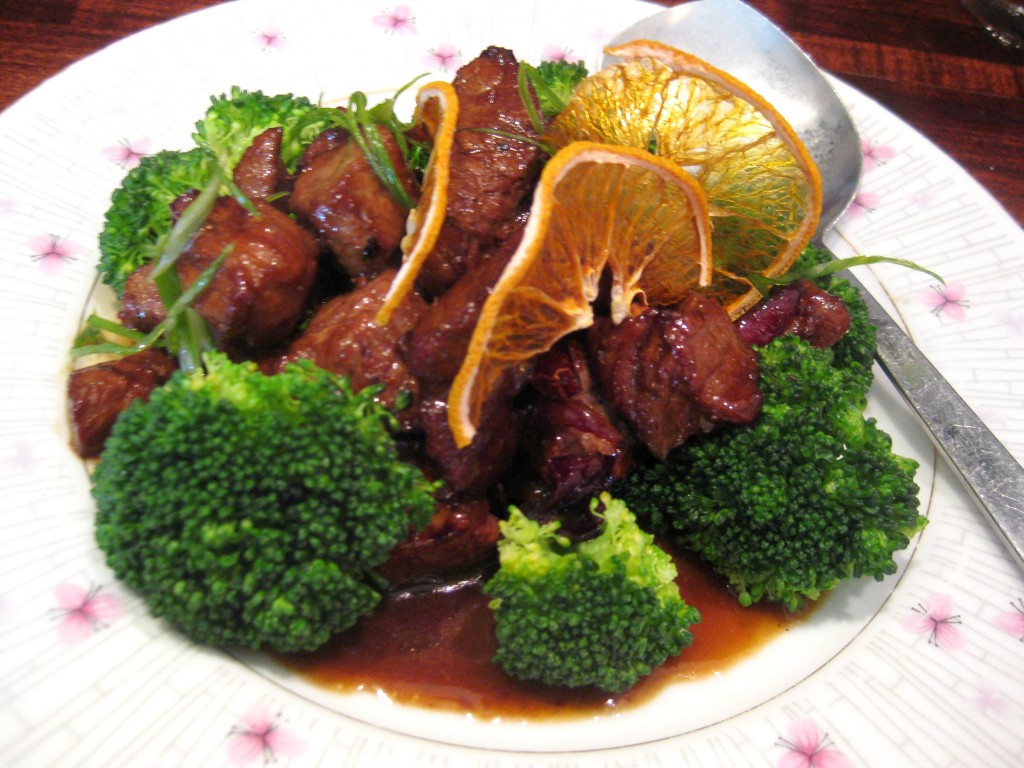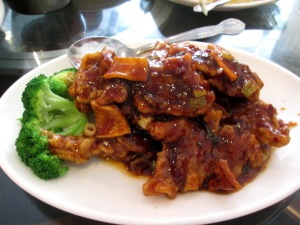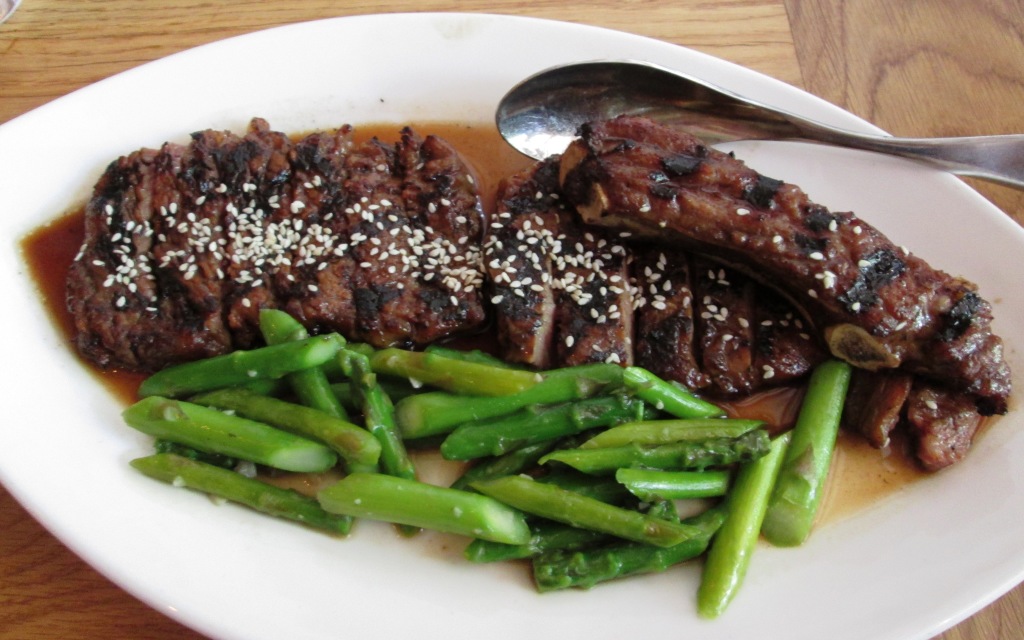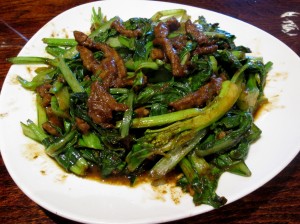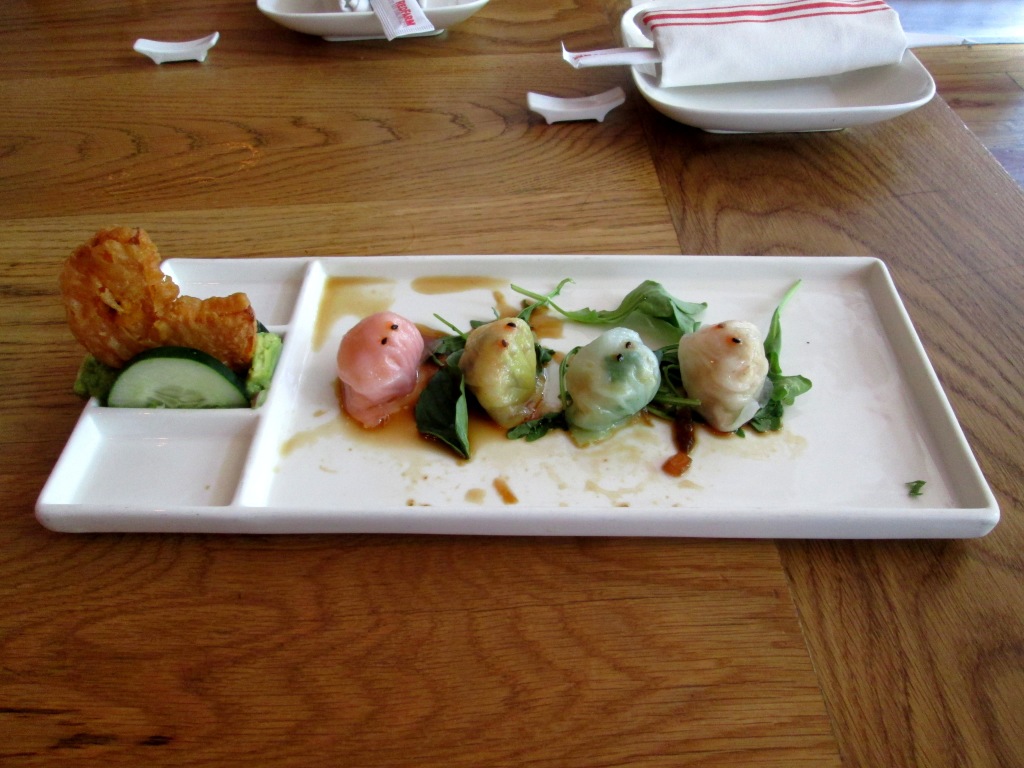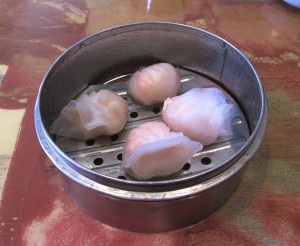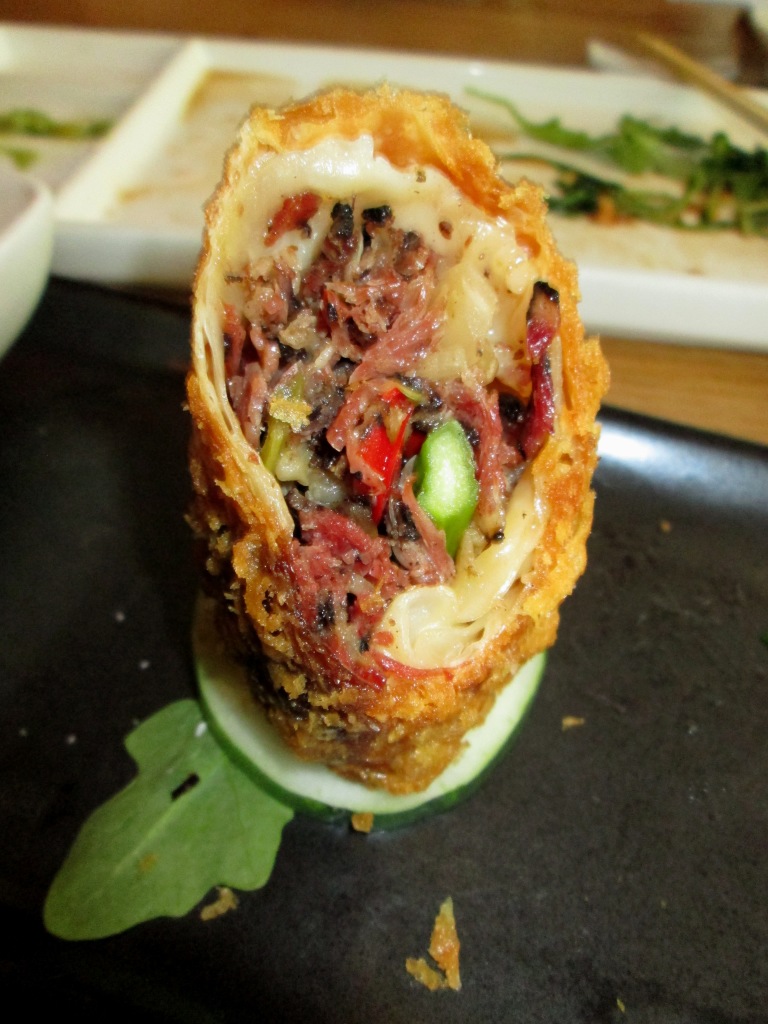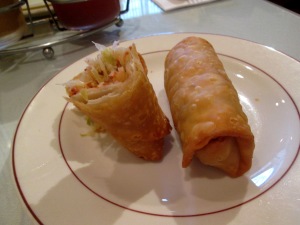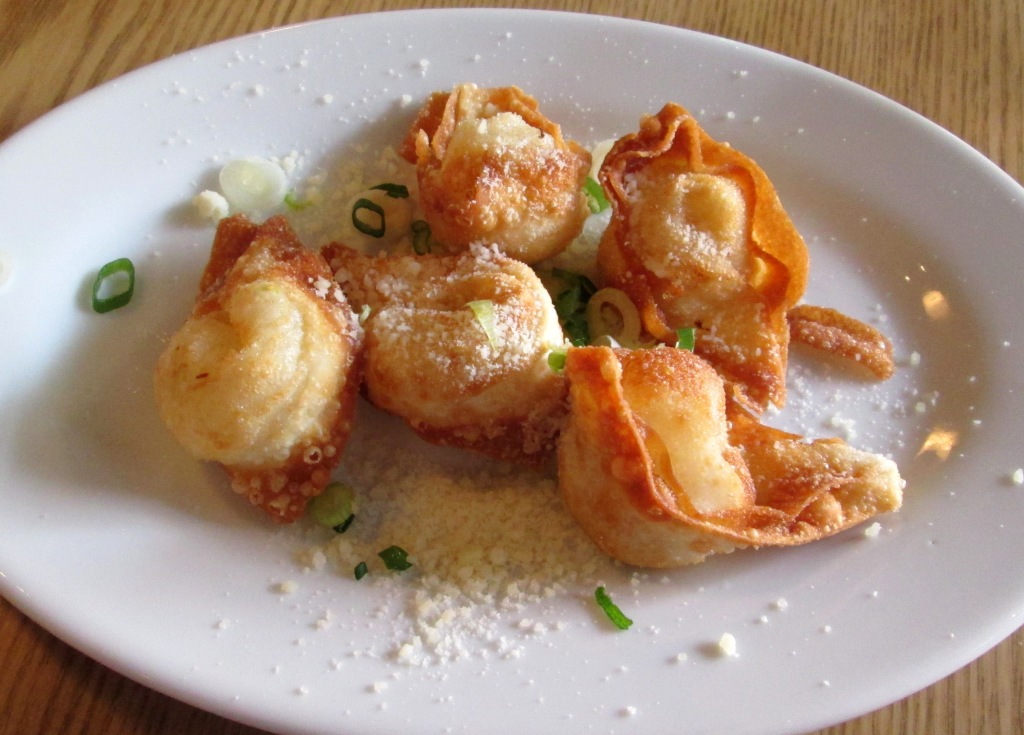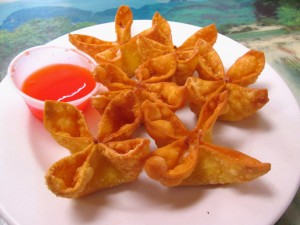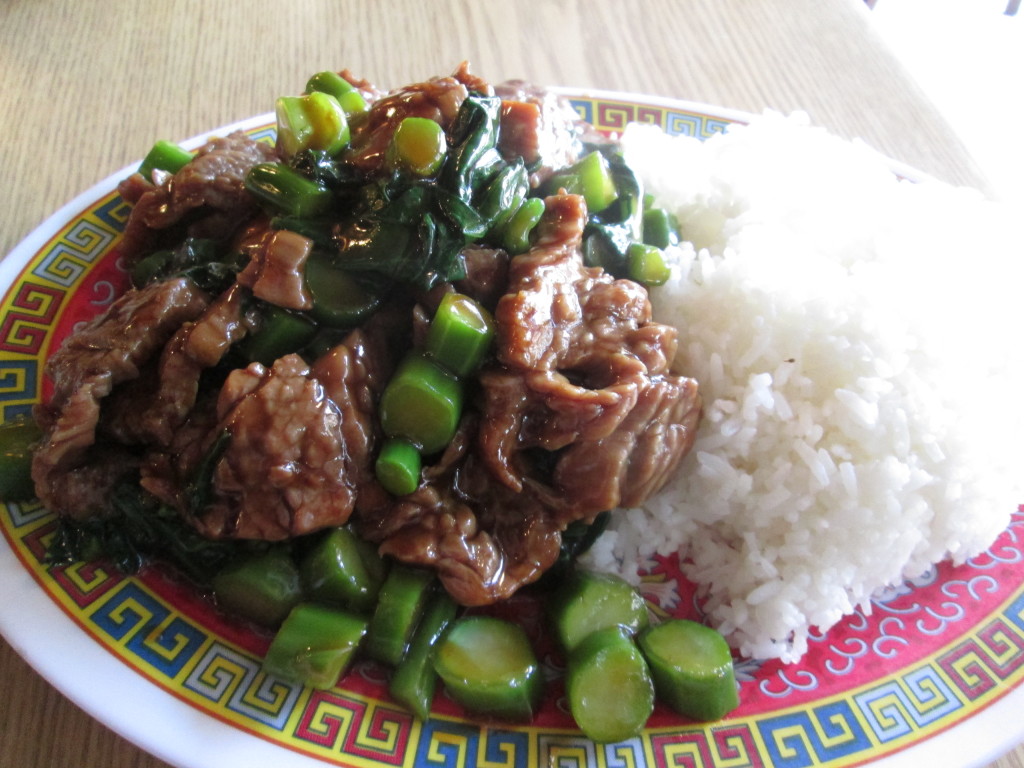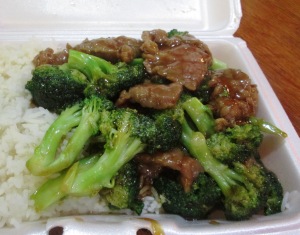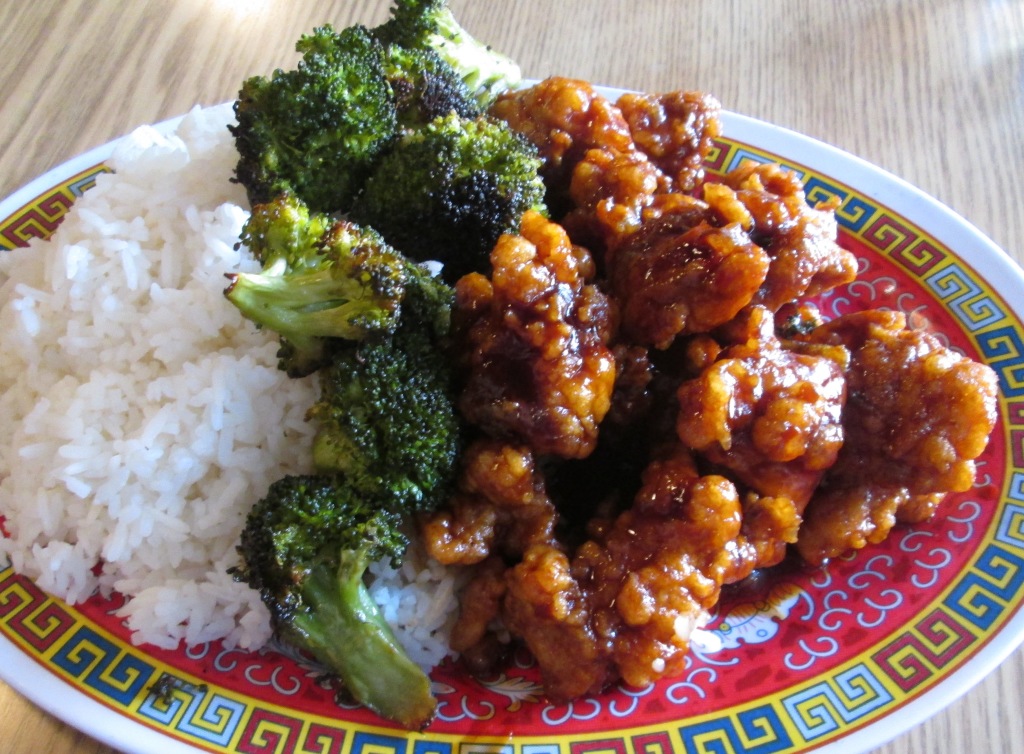(by Corbo Eng)
There‚Äôs no doubt that, even as their brethren were still toiling away‚Äîperhaps, blasting through once impenetrable mountains or laying down yet more rail‚Äîthat, back at the dining camp, the Chinese laborers, tasked with cooking the day‚Äôs meal, were already thinking about how to tweak and improve what they were making.¬Ý Even though their primary responsibility wasn‚Äôt to cook or to necessarily impress anyone, those pioneering cooks who participated in building the Transcontinental Railroad (and, who, arguably, introduced Chinese food to this country) couldn‚Äôt have rested on their laurels.¬Ý Who wouldn‚Äôt have wanted to add some pungent garlic and oysters to a simple bowl of boiled rice and leftover pork?
Granted, those first, pioneering Chinese ‚Äúchefs‚Äù were mostly concerned with basic nourishment (particularly, when they were mired in such hard work); but, there was probably a corresponding impulse also to improve on quality and make what they were all eating in the camp better for its own sake.¬Ý To do so would invariably have meant adding new or foreign ingredients (whatever they were given) or turning a traditional dish‚Äîperhaps, something that they missed from back home in China‚Äîinto the first ‚ÄúAsian-fusion‚Äù food (long before such cleverness was called into attention).¬Ý Too bad for us that there were no camera phones and Instagram to capture it all.
Fast forward one hundred and fifty years and that impulse continues to thrive‚Äîespecially, now, when chefs, Chinese or otherwise, who are preparing Chinese food are cooking in a milieu where sustenance is no longer a factor and creativity and, very likely, one-upsmanship are.¬Ý In fact, now, with all manner of Asian food experiencing a level of unprecedented notoriety‚Äîand, with acclaimed chefs leading the charge‚ÄîChinese food (although, less trendy than some of its peer-cuisines) isn‚Äôt immune to a little bit of fuss and reinterpretation too. ¬ÝIndeed, for every chef who‚Äôs churning out Korean tacos and sushi burritos, there are those who are reexamining Chinese dishes as well.
Take Dale Talde, for example, whose penchant for reinvention has become his calling card at Talde, his namesake restaurant in Park Slope, Brooklyn.¬Ý There, the former Top Chef star has enlisted his Filipino-American background, his experience at Manhattan’s acclaimed Buddakan, and his keen instincts to recreate everything from Korean fried chicken to pad thai.¬Ý Chinese dishes are treated no differently. Wonton noodle soup, the quintessential Cantonese comfort food, gets a new treatment at Talde.¬Ý Perhaps, its status as an essential item at Chinatown eateries and Chinese BBQ joints makes it an easy target for reinterpretation‚Äîthat, and, perhaps, more likely, the fact that it provides an easy bridge to Japanese ramen (something that is immensely popular right now and prone to new iterations).¬Ý The two soups are very similar at their core; and, with ramen having Chinese origins, Talde’s reinvention, which blends the two, is a clever twist that knots the pair together in ways in which enthusiasts of noodle soups would undoubtedly approve.
In this new version, instead of the usual and familiar egg noodles, Chef Talde employs ramen noodles.¬Ý Cooked to an al dente tenderness, the noodles are paired with wontons.¬Ý Lumpy, bulbous, and filled with the same porky mixture that graces the restaurant’s famed pretzel pork and chive dumplings, the wontons float in a soup that‚Äôs already crowded with pretty strips of smoked pork and one obligatory poached egg.¬Ý A garnish of bitter greens and scallions add a seemingly innocuous final touch.¬Ý The broth itself, yellowish and faintly cloudy, resembles the appearance of tonkotsu broth.¬Ý In terms of taste, it lacks the astringent or insistent saltiness that many tonkotsu broths possess.¬Ý Instead, this is a wonton broth with hybrid charm.¬Ý There is subdued saltiness but with the tones of wonton soup still intact.
The wontons are meaty and ambitious; but, the smoky strips of pork shoulder, bobbing next to them, are the most outstanding even as they appear to be a secondary feature.¬Ý Leaching smoke and flavor, the tender strips add smokiness to the proceedings‚Äîwhich is all the more potent when the broth is still piping hot from the kitchen and the smoky essence hasn’t had time to dissipate.¬Ý The egg is good‚Äînot overly cooked; instead, it‚Äôs bright, honest, and not runny (for those who like a poached egg with integrity).
However, another dish, called simply ‚ÄúChow Fun,‚Äù ups the ante considerably.¬Ý With this entry, the moves are riskier and bolder as Chef Talde attempts to radically reinterpret classic Cantonese chow fun‚Äîof which, beef chow fun is the most revered and famous.¬Ý In the traditional version, broad strips of chow fun (wide rice noodles) are stir fried with beef, bean sprouts, onions, and scallions and may be served with a brown gravy or, more popularly, simply ‚Äúdry‚Äù (with the wok giving the ingredients a signature sear and smokiness). Talde‚Äôs remake substitutes braised pork shank for the usual strips of filleted beef; but, the daring is in the handling of the chow fun noodles‚Äîor noodle to be more exact.¬Ý Rather than featuring broad strips of rice noodles as is customary (piled haphazardly, like pasta, on a plate), Talde rolls one thick, long strand of chow fun noodle into a curled mass (kind of like how one would roll a leather belt in order to tuck it away inside a suitcase).¬Ý Once plated as the centerpiece, the curled chow fun noodle is surrounded by a ring of the aforementioned braised pork and pickled greens.¬Ý For those used to beef chow fun, this reworking is quite jarring, indeed.
The top side of the curl is pan-seared to a golden, crispy finish; and, as the strand is stabbed with one‚Äôs fork, it unwinds and breaks up to reveal the unseared underside.¬Ý The pork, which is prepared in a braising liquid of Chinese five-spice, soy sauce, rice wine, and vinegar, aromatically emits hints of its constituent ingredients‚Äîparticularly, star anise.¬Ý The meat is rich, tasty, but salty and is aided by the sour jabs of pickled greens.¬Ý The noodle, once unraveled and dismembered, tastes a bit firmer than typical‚Äîwith the seared side, understandably, providing the most attractive bites.
Orange beef, that B-List mainstay of Chinese-American fare, finds expression at Talde in a dish called Orange Beef Ribeye and Broccoli.¬Ý This dish exchanges the usual breaded and fried slices of beef‚Äîtypically, a poor cut of one variety or another‚Äîfor neatly parceled pieces of ribeye; and, instead of being submitted to the deep fryer, the meat is left unbattered and stir fried in a wok.¬Ý Overall, however, the stakes are perceptibly lower with this dish (unlike with the Chow Fun).¬Ý Using a better cut of beef and employing a better cooking method, the end product is correspondingly more hearty and delicate than typical orange beef, which has a gloppy, unmistakably fried finish to it.
The pieces of ribeye are unabashedly and recognizably pieces of steak, which isn’t stating an obvious point when orange beef can take on all kinds of mysterious appearances.¬Ý The typically syrupy orange coating, which is made with sugar, cornstarch, and dashes of orange juice, is replaced in Talde’s version with a less sugary and cloying variation that offers manageable hints of sweet tang.¬Ý A few bites of the gossamer thin garnishes of orange (flash fried to a crispy finish and looking like translucent butterfly wings) provide bursts of distinctively orangy flavor.¬Ý The garnish of steamed broccoli florets add a classic connection to the original dish.¬Ý In sum, Talde’s orange ribeye, while not a radical departure, allows diners to hit the refresh button to taste this dish anew.
At RedFarm in the West Village, however, where, for the past few years, restaurateur, Ed Schoenfeld (New York’s impressario of Chinese food), and dim sum master, Joe Ng have made their mark by yanking Chinese food out from its time capsule into a distinctly modern era, one of the prominent elements in that forward charge has been the judicious and skillful ways in which they have served steak…yes, steak.¬Ý Given Chef Ng’s dim sum pedigree and steak’s seemingly incongruent presence on a Chinese menu, it is an unlikely force in such a setting, but, showcased and prepared brilliantly, the end result is attention grabbing‚Äîin a way that stretches and redefines the boundaries.
The grilled, marinated prime rib steak (sourced from Creekstone Farms and Pat LaFrieda) is inspired by a dish called, Sha Cha Beef (sometimes, spelled, ‚ÄúSa Cha‚Äù), which, traditionally, consists of beef stir fried with sha cha sauce and served with a green vegetable such as Shanghai bok choy or broccoli crowns.¬Ý Sha cha sauce, which is considered a type of Chinese barbecue sauce, is more paste-like than saucy and is often used to flavor the broth in Chinese hot pots or, more typically, as a rub on meats.¬Ý Made from garlic, shallots, and dried shrimp (among other things), it offers a kick of umami, which undoubtedly contributes to sha cha‚Äôs resilient popularity.
The sha cha sauce is part of the post wet-aged marinade, which is an amalgam of the aforementioned sha cha, soy sauce, black pepper, and a potent enzymatic dose of papaya nectar that both flavors and tenderizes the already top quality rib steak.¬Ý While, traditionally, a bombastic dollop or two of sha cha is also used to dress and lubricate the meat while being stir fried, the version at RedFarm, instead, trades an otherwise potentially overwhelming cover of sha cha for a delicate, brothy base of it that also gives off hints of soy and ginger.¬Ý To finish, the steak receives a final douse of sesame seeds and is plated next to fresh, bright, aspiring stalks of asparagus. The prime rib steak, as a reinterpreted stand-in, simply impresses.¬Ý The meat, which is cooked to a perfect medium rare and pre-sliced before being served, bursts with intense flavor.¬Ý It‚Äôs beefy, rightfully tender, and slightly sweet from tip-toeing accents of sha cha, soy, and residual nectar (as well as insistently smoky from grilling and charring).¬Ý Ultimately, each bite melts in one‚Äôs mouth without the requisite fat that would usually be present to usher in that sensation.¬Ý The asparagus, filling in for the bok choy, yu choy, celery, broccoli (or other green vegetable) that surely wouldn‚Äôt have been as praiseworthy, sparkles in its complementary role.
Even as the prime rib steak is an unqualified hit, Chef Ng doesn’t really flex his muscles more than when he is making dumplings‚Äîand drawing from his dim sum training in Hong Kong and from his immense repertoire.¬Ý Ed Schoenfeld has even said that Ng, having mastered his craft, is capable of making, at least, a hundred different kinds of dumplings; but, none is more emblematic than the Pac Man shrimp dumplings, which, arguably, have become RedFarm’s most famous menu item. Consisting of a quartet of colored dumplings, which are representations of the antagonistic ‚Äúghosts‚Äù from the classic Pac Man video game, and one crescent-shaped wedge of sweet potato tempura that is a stand-in for Pac Man himself, the whimsical platter is, certainly, visually appealing.¬Ý The characters, as it were, come ‚Äúalive‚Äù in three dimensional form (with Pac Man in aggressive pursuit of the retreating ghosts).
The thin, colorful dumplings, are almost too artful to eat; but, when consumed are resoundingly good.¬Ý Like the ghosts that inspired them, the four shrimp dumplings differ in ‚Äútemperament‚Äù and ‚Äúpersonality.‚Äù¬Ý Besides shrimp, the pink ghost contains lobster; the yellow, leeks and mushrooms; the blue, blue crab; and, the white one, bamboo shoots.¬Ý Each dumpling, with its constituent ingredients, has a clean wisp of brininess and is defined by slight textural variations that go beyond the standard issue “har gow” dumplings, the classic dim sum staple, that inspired them.¬Ý As for the the Pac Man-shaped wedge of sweet potato tempura, it is crispy and well executed and appropriately hot from the fryer (like a post-power pill Pac Man undoubtedly would be).
Chef Ng has also garnered deserved praise and attention for his take on egg rolls‚Äîwhich, at RedFarm, are dubbed, “Katz’s Pastrami Egg Rolls.”¬Ý Filled with savory pastrami, presumably from famed Katz‚Äôs Delicatessen (as its name indicates), these revamped egg rolls not only pay homage to the iconic Lower East Side institution, where the staff and regular clientele practically bleed pastrami, but also to Ed Schoenfeld’s¬Ý Jewish heritage.
Once chopped, diced, and stuffed inside an egg roll wrapper, the first-rate pastrami, which is bolstered by bits of asparagus and an aioli-like binder, duly outperforms the usually insipid cabbage and celery-based fillings that typify most egg rolls.¬Ý As well, the exterior of Chef Ng’s creations are fried to a sinister crispiness; its skin is, at once, both magnificently flaky and blistered (as if the egg rolls had passed through the fiery breath of a mythological Chinese dragon).¬Ý Dabbed in an accompanying honey mustard dressing (a deft substitute for the usual sinus-clearing Chinese mustard), the pastrami egg rolls are elevated even more.
Another Chinese restaurant of the same ilk, calling itself Brooklyn Wok Shop, located in Williamsburg, has picked up on the fact that reinterpretation can come in rather small packages.¬Ý Treating morsels of dim sum and potentially dismissed appetizers as prime aspects of his arsenal, Chef Edric Har has taken up the mantle of breathing new life into these items. One of his works in this effort is his take on the ubiquitous but pedestrian carryout appetizer crab rangoon.¬Ý Typically, crab rangoon are fried wontons, shaped to look like folded bulbs (like soup wontons) or, alternatively, formed into geometric pouches of one sort or another, that contain imitation crab meat (thus, the name) and cheese (invariably, cream cheese).¬Ý At Brooklyn Wok Shop, Chef Har goes for the former shape‚Äîfilling his wontons with lump crab and cream cheese before frying them to a pleasing, crispy golden brown.¬Ý A dusting of Parmesan cheese and a garnish of freshly sliced scallions finish off the dish.¬Ý The fried wontons are delicious‚Äîwith the creaminess of the cheese, crunch of the wonton wrapper, and the brightness of the scallions enhancing each other’s gifts.
Even the sprinkle of Parmesan cheese adds a bit of salty funk that only lifts the whole.¬Ý The lump crab, however, is seemingly lost or even absent.¬Ý One of Chef Har’s main objectives is to use high quality ingredients and to raise the level of the typical Chinese dish in which these ingredients are featured; and, certainly, the inclusion of such crab meat is employed to that end.¬Ý Too bad, the crab, lump or otherwise (and included in whatever proportion), is totally overwhelmed by everything else around it.
Shifting his focus to main courses, Har serves a handful of one plate meals (like the kind that are found at Chinatown dives, carryout shops, and that are featured as lunchtime specials at Chinese restaurants of varying persuasions).¬Ý The updated versions of these at Brooklyn Wok Shop are called, “Rice Entrees” on the restaurant’s menu.
There may not be a more classic and time-honored option in this case than beef and broccoli, which almost every Chinese restaurant (particularly, those with Cantonese tendencies) probably serves in one form or another.¬Ý Chef Har, putting his personal stamp on this dish, has replaced the usual flank or eye round filets and opted for slices of hanger steak (which, currently, is popularly found on many steakhouse and gastropub menus).
Ultimately, and on its face, it’s a very good choice.¬Ý The slices of hanger steak are prepared well; they’re tender and flavorful.¬Ý Biting into each savory piece is a reminder that this is beef and broccoli at a high level and better than most.¬Ý And, the inclusion of Chinese broccoli (gai lan), rather than its more conventional “Western” counterpart, takes the dish into a seemingly more authentic and, secondly, more tasty direction.¬Ý Cut into leafy clumps and bite-sized coins, the bits of Chinese broccoli soak up some of the surrounding sauce (which tastes like a traditional concoction of oyster sauce, sugar, and soy) and still provide a fresh and admirable crunch.
But, here’s the catch.¬Ý Given that Chef Har is French trained and has cut his teeth at restaurants like Veritas and the stellar, Le Bernardin, and that Brooklyn Wok Shop is a member of a new generation of Chinese restaurants (and that it’s located in trendsetting Williamsburg no less), what’s lacking is more pizzazz and creativity.¬Ý The riff on the classic beef and broccoli is good; but, really, the reinterpretation is minor.¬Ý The bar isn’t raised high enough.¬Ý One should expect more.
In fact, many of the better Chinatown dives and restaurants (some displaying seafood tanks to indicate their prowess‚Äîrelating to seafood or otherwise) are capable of duplicating the same results.¬Ý With their secretive methods of tenderizing and velveting meat, tender slices of beef is not alien to these places (regardless of the cuts with which they started).¬Ý And, using a variation of oyster sauce to dress it up isn’t that hard either.¬Ý What many Chinese restaurants wouldn’t do unless they have a heavy Chinese customer base is use Chinese broccoli; but, the aforementioned Chinatown establishments would.¬Ý Sticking with traditional practice, however, they would lean toward presenting the broccoli as stalks rather than as bite-sized pieces.
Something like General Tso’s Chicken, as well, seemingly provides ample room for reinterpretation and enhancement; yet, following the lead of Chef Har’s take on beef and broccoli, the refined edition of this Chinese-American staple at Brooklyn Wok Shop, again, aims too low.
Apparently, Har’s major twist is using all white meat chicken‚Äîwhich, increasingly, isn’t such a rare case at Chinese restaurants anymore.¬Ý In promoting his restaurant, Har even touts it as a healthier alternative.¬Ý But, once breaded, fried, and slathered in that familiar tangy and sweet exterior coating of sauce, the health benefits of using white meat is surely diminished.¬Ý What’s left is an admittedly tasty final product that hits all of the familiar notes (crunchy texture, slightly cloying sauce)¬Ý that, quite assuredly, would be at home on a Formica table in a self-respecting Chinese restaurant anywhere‚Äîin Fresno, Duluth, or Kalamazoo¬Ý (minus the roasted broccoli, of course, which, honestly, isn’t all that it could be).
If the present thrust of Asian cuisine were a Broadway show, we¬Ýmay very well be past intermission and ready to shuffle in from our bathroom break given the speed at which restaurants are opening¬Ýup and chefs, fueled by imagination and a desire to remake what they know, are pushing the envelope.¬Ý It‚Äôs hard to say how it will all end; but, for every new dish that attempts to reinterpret Chinese food and expand its boundaries, the cuisine is kept fresh and alive. ¬ÝSure, there will be continued hits and misses; but, to avoid becoming staid and out-dated, there’s nothing as vital as forward movement (however, long or short the advancement may be).¬Ý In today’s dining scene, that’s as important as anything.
Copyright 2013 (Corbo Eng). ¬ÝAll Rights Reserved. All photos by Corbo Eng (except photo of Chinese laborers).


